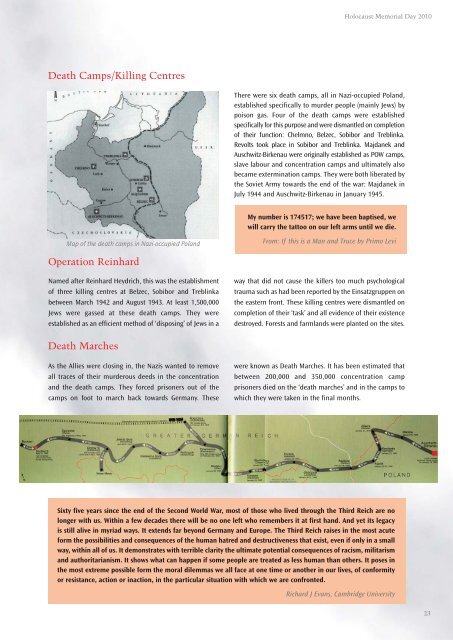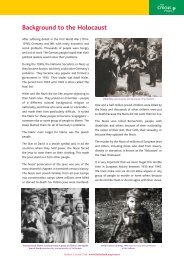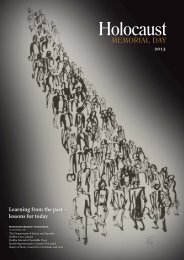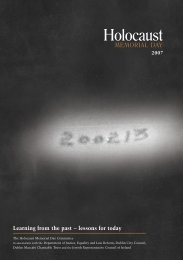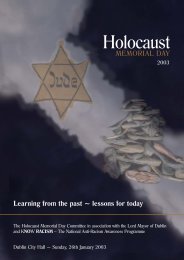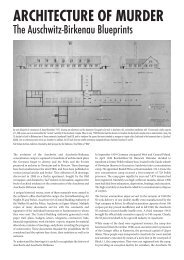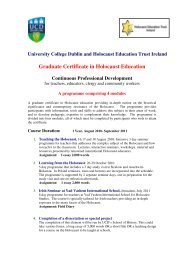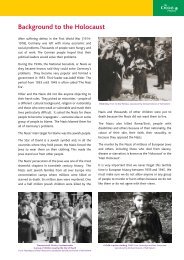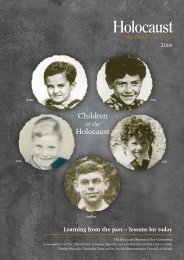Learning from the past ~ lessons for today - Holocaust Education ...
Learning from the past ~ lessons for today - Holocaust Education ...
Learning from the past ~ lessons for today - Holocaust Education ...
You also want an ePaper? Increase the reach of your titles
YUMPU automatically turns print PDFs into web optimized ePapers that Google loves.
<strong>Holocaust</strong> Memorial Day 2010<br />
Death Camps/Killing Centres<br />
There were six death camps, all in Nazi-occupied Poland,<br />
established specifically to murder people (mainly Jews) by<br />
poison gas. Four of <strong>the</strong> death camps were established<br />
specifically <strong>for</strong> this purpose and were dismantled on completion<br />
of <strong>the</strong>ir function: Chelmno, Belzec, Sobibor and Treblinka.<br />
Revolts took place in Sobibor and Treblinka. Majdanek and<br />
Auschwitz-Birkenau were originally established as POW camps,<br />
slave labour and concentration camps and ultimately also<br />
became extermination camps. They were both liberated by<br />
<strong>the</strong> Soviet Army towards <strong>the</strong> end of <strong>the</strong> war: Majdanek in<br />
July 1944 and Auschwitz-Birkenau in January 1945.<br />
My number is 174517; we have been baptised, we<br />
will carry <strong>the</strong> tattoo on our left arms until we die.<br />
Map of <strong>the</strong> death camps in Nazi-occupied Poland<br />
From: If this is a Man and Truce by Primo Levi<br />
Operation Reinhard<br />
Named after Reinhard Heydrich, this was <strong>the</strong> establishment<br />
of three killing centres at Belzec, Sobibor and Treblinka<br />
between March 1942 and August 1943. At least 1,500,000<br />
Jews were gassed at <strong>the</strong>se death camps. They were<br />
established as an efficient method of ‘disposing’ of Jews in a<br />
way that did not cause <strong>the</strong> killers too much psychological<br />
trauma such as had been reported by <strong>the</strong> Einsatzgruppen on<br />
<strong>the</strong> eastern front. These killing centres were dismantled on<br />
completion of <strong>the</strong>ir ‘task’ and all evidence of <strong>the</strong>ir existence<br />
destroyed. Forests and farmlands were planted on <strong>the</strong> sites.<br />
Death Marches<br />
As <strong>the</strong> Allies were closing in, <strong>the</strong> Nazis wanted to remove<br />
all traces of <strong>the</strong>ir murderous deeds in <strong>the</strong> concentration<br />
and <strong>the</strong> death camps. They <strong>for</strong>ced prisoners out of <strong>the</strong><br />
camps on foot to march back towards Germany. These<br />
were known as Death Marches. It has been estimated that<br />
between 200,000 and 350,000 concentration camp<br />
prisoners died on <strong>the</strong> ‘death marches’ and in <strong>the</strong> camps to<br />
which <strong>the</strong>y were taken in <strong>the</strong> final months.<br />
Sixty five years since <strong>the</strong> end of <strong>the</strong> Second World War, most of those who lived through <strong>the</strong> Third Reich are no<br />
longer with us. Within a few decades <strong>the</strong>re will be no one left who remembers it at first hand. And yet its legacy<br />
is still alive in myriad ways. It extends far beyond Germany and Europe. The Third Reich raises in <strong>the</strong> most acute<br />
<strong>for</strong>m <strong>the</strong> possibilities and consequences of <strong>the</strong> human hatred and destructiveness that exist, even if only in a small<br />
way, within all of us. It demonstrates with terrible clarity <strong>the</strong> ultimate potential consequences of racism, militarism<br />
and authoritarianism. It shows what can happen if some people are treated as less human than o<strong>the</strong>rs. It poses in<br />
<strong>the</strong> most extreme possible <strong>for</strong>m <strong>the</strong> moral dilemmas we all face at one time or ano<strong>the</strong>r in our lives, of con<strong>for</strong>mity<br />
or resistance, action or inaction, in <strong>the</strong> particular situation with which we are confronted.<br />
Richard J Evans, Cambridge University<br />
23


